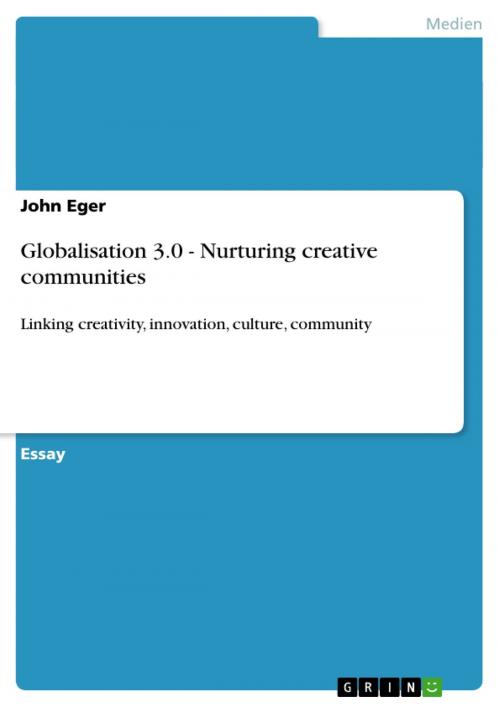Globalisation 3.0 - Nurturing creative communities
Linking creativity, innovation, culture, community
Nonfiction, Computers, Application Software, Multimedia| Author: | John Eger | ISBN: | 9783640888115 |
| Publisher: | GRIN Verlag | Publication: | April 8, 2011 |
| Imprint: | GRIN Verlag | Language: | German |
| Author: | John Eger |
| ISBN: | 9783640888115 |
| Publisher: | GRIN Verlag |
| Publication: | April 8, 2011 |
| Imprint: | GRIN Verlag |
| Language: | German |
Essay aus dem Jahr 2011 im Fachbereich Medien / Kommunikation - Multimedia, Internet, neue Technologien, San Diego State University, Sprache: Deutsch, Abstract: In less than 15 years, the mammoth global network of computer systems collectively referred to as the Internet has blossomed from an obscure tool used by government researchers and academics into a worldwide mass communications medium. The Internet is now recognized as the leading carrier of all communications and financial transactions affecting life and work in the 21st century. The growth of the Internet's now widely popular component, the World Wide Web, has been even more spectacular. With more than 3 billion users worldwide and a growth rate of unparalleled in the history of electronic services or devices like the telephone or television, the Internet is being integrated into the marketing, information, and communications strategies of almost every major corporation, educational institution, charitable and political organization, community service agency, and government entity in the developed world. In recent years, people habitually have referred to the domain in which Internet-based communications occur as 'cyberspace,' an abstract communications space that exists both everywhere and nowhere. But until flesh-and-blood humans can be digitized into electronic pulses in the same way that computer scientists transform images and data, the denizens of cyberspace will have to continue living in some sort of real physical space, an environment that will continue to dominate our future in the same way that our homes, neighborhoods, and communities do today.
Essay aus dem Jahr 2011 im Fachbereich Medien / Kommunikation - Multimedia, Internet, neue Technologien, San Diego State University, Sprache: Deutsch, Abstract: In less than 15 years, the mammoth global network of computer systems collectively referred to as the Internet has blossomed from an obscure tool used by government researchers and academics into a worldwide mass communications medium. The Internet is now recognized as the leading carrier of all communications and financial transactions affecting life and work in the 21st century. The growth of the Internet's now widely popular component, the World Wide Web, has been even more spectacular. With more than 3 billion users worldwide and a growth rate of unparalleled in the history of electronic services or devices like the telephone or television, the Internet is being integrated into the marketing, information, and communications strategies of almost every major corporation, educational institution, charitable and political organization, community service agency, and government entity in the developed world. In recent years, people habitually have referred to the domain in which Internet-based communications occur as 'cyberspace,' an abstract communications space that exists both everywhere and nowhere. But until flesh-and-blood humans can be digitized into electronic pulses in the same way that computer scientists transform images and data, the denizens of cyberspace will have to continue living in some sort of real physical space, an environment that will continue to dominate our future in the same way that our homes, neighborhoods, and communities do today.















